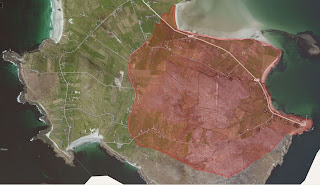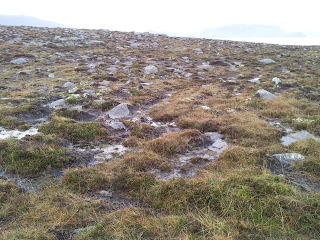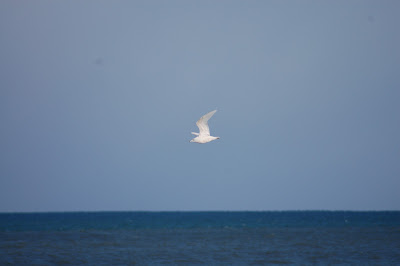Lots of birders will have
visited my patch at some time. Some may even have had a tick or two in my
patch. For about 49 weeks of the year, I have my patch pretty much to myself.
For three weeks in the autumn, I can’t move for birders! My patch is the Virkie,
Toab and Exnaboe area in south mainland Shetland.
I finally put roots down in
Shetland in June 2007, after a rather protracted move from Leicester. Anybody
who has birded the Virkie Willows, or looked on the Pool of Virkie from the
well-known turning-circle, will have seen my house: it’s the one closest to the
Virkie Willows.
I define my patch as per the
map below: basically, the bit of land between Sumburgh Airport to the south and
Ward Hill to the north. The area lives in the shadow of Sumburgh Head somewhat,
which steals a lot of my migrant birds, but a bit of persistence over the years
has certainly paid off.

The obvious focal point is the
Pool of Virkie, possibly one of the best sites in the whole of the UK for rare
waders over the years. I can see much of this tidal pool from my kitchen
window, which is handy. The list of wader rarities recorded on the pool is
enviable: before my time in Shetland, such cripplers as Western Sandpiper,
Red-necked Stint, Least Sandpiper and Sharp-tailed Sandpiper were recorded, not
to mention Britain’s first Great Knot. Since my time here, I’ve found
Shetland’s second Marsh Sandpiper on the pool, along with three different
White-rumped Sandpipers and a couple of Pectoral Sandpipers. Initially found by
others, Killdeer, Semipalmated Sandpiper and American Golden Plover have all
found their way on to my patch (and house) list too, although a Baird’s
Sandpiper during the summer of 2007 was a bad dip for me. Being a shallow tidal
estuary, the pool isn’t much good for wildfowl, but as my patch lacks any fresh
water at all (bar the odd puddle in a field), it’s the only place where I might
encounter such species. Long-tailed Duck, Eider and Goldeneye are regular in
the winter, and I’ve managed to scrape up Slavonian Grebe, Scaup and even a
King Eider on the pool over the years. Occasionally ducks fly over the patch,
the best by far being a pair of Black Ducks that had been nearby at Scatness
and which, knowing they had just been flushed by a dog-walker, I managed to get
on the patch list by climbing onto the roof of my house and watching them fly
along the west side of Toab!


Away from the Pool of Virkie,
my patch consists of the settlements of Toab, Exnaboe and Eastshore, and the
adjacent agricultural land. Farming in my patch is mainly of the sheep variety,
therefore much of the area is grass fields which aren’t usually of any great
interest ornithologically. However, there are usually four or five small crop
fields each year of neeps and/or tatties (or turnips and potatoes if you
prefer), and these are a magnet for migrants in the autumn. Neeps are the best,
as they tend to stay in the ground for longer and aren’t harvested until much
later in the autumn. During my time, such crops have produced a couple of
Pechora Pipits, Yellow-breasted Bunting, Short-toed Lark, Arctic Redpoll and
Little Bunting amongst others.
The gardens of Toab are
well-known to any birder who has visited south mainland Shetland, and have a
good list of past glories, including Black-throated Thrush, Pied Wheatear and
Black-headed Bunting. Despite getting on for six years of thrashing these
gardens myself, the best I’ve found has been an Olive-backed Pipit, a Radde’s
Warbler and a Coal Tit (the latter being by far the rarest in Shetland terms!),
whilst an Isabelline Shrike in Toab during the autumn of 2012 was very popular
with visiting and resident birders alike. The Toab gardens will virtually
guarantee me Yellow-browed Warbler, Red-backed Shrike, Common Rosefinch,
Icterine Warbler and Barred Warbler each year – all easy as ‘self-found’ birds
and one of the many advantages of living in Shetland.


Less well-known are the
gardens at Exnaboe, which are my favourite gardens in the patch (probably
because they are less well-known, and therefore less visited, by other
birders). They seem particularly attractive to rare phylloscs – over the last few years I’ve found Arctic, Greenish and
Dusky Warbler in these gardens. One of these days I’ll find something truly
spectacular there. Exnaboe was also the site of the Sandhill Crane in 1991.

Finally... Eastshore. Not a
site that will have registered with many people before October 23rd 2012. The
Eastshore road is the one that runs along the northern edge of the Pool of
Virkie. At the west end, nearest the main road, are the famous Virkie Willows,
which have produced many a good bird, including Pallas’s Grasshopper Warbler
and ‘Caspian’ Stonechat (both before my time), and Pechora Pipit and Ortolan
Bunting since I’ve been here. My own garden is now maturing nicely – best bird
so far actually in the garden is Subalpine Warbler, but I’ve had multiple
Bluethroats, Wrynecks, Red-backed Shrikes, Barred Warblers and Yellow-browed
Warblers too, and the Pallid Harrier I found from my garden will live long in
the memory. I have high hopes for my recently-dug pond, which I am convinced
will one day attract a Siberian Blue Robin – for now, my ‘pond list’ consists
of House Sparrow, Starling, Blackbird, Willow Warbler, Waxwing, Rock Dove, Blue
Tit and my dog!

There are a few other gardens
along the Eastshore road, which nobody ever looks in (and I somehow manage to
ignore much of the time too). I’ve always thought they had potential, and this
was realised somewhat joyously, yet painfully, on the date mentioned above:
Chestnut-eared Bunting! (The recent write-up in Birding World will
explain the pain behind this bird).
And then there’s the Magic
Ditch. There is nothing ever in the Magic Ditch. I plod along it every day in
the spring and autumn, seeing nothing (although the dog likes the walk). The
reason I continue to look in the Magic Ditch is because, over the space of
three fateful days in September 2008, there was a Paddyfield Warbler and a
Thrush Nightingale in the Magic Ditch. Since then... well, I did find a Great
Snipe adjacent to the Magic Ditch in 2011, but apart from that the highlights
have been a Robin, a Sedge Warbler and several Meadow Pipits. Looks good for a
Pallas’s Gropper though...
So far, this description of my
patch has concentrated on migrants/rarities – so what of the ‘regular’ stuff? Typical
Shetland birds such as Twite, Rock Dove, Bonxie, Arctic Skua, Whimbrel, Black
Guillemot etc are all easily seen. However, breeding landbirds are restricted
to House Sparrow, Starling, Blackbird, Sky Lark, Meadow Pipit, Rock Pipit,
Wren, Wheatear, Hooded Crow and Raven, whilst a small population of Linnets
(still a scarce bird in Shetland away from south mainland) has recently become
established. ‘Common’ birds elsewhere in the UK can be difficult to come by:
Blue Tit was a mega patch tick this autumn, a Stock Dove this November was only
the second I’ve seen in my patch, I was gutted to miss a Long-tailed Tit in
Toab a few years ago, I still need Yellowhammer, Little Grebe and Pochard, and
have next to no chance of Magpie, Jay, Willow Tit, Tawny Owl or Little Owl!
My personal patch list
currently stands at 212 and, after a bit of investigation, I think the total number
of species recorded in my patch is probably 258. My goal for 2013: surely it’s
about time I found a bluetail in Toab?
Sorry to have waffled on so
much...
Rob




.JPG)

































